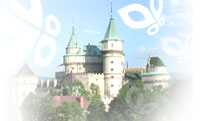

 |
 |
|
| Slovakia´s best facts history UNESCO sights nature sights gastronomy spas swim cyclistics skiing |
SLOVAK HISTORY5th centuryThe original Slavic population settled the general territory of Slovakia in the 5th century. Slovakia was part of the center of Samo's empire in the 7th century. The highest point of the 9th-century proto-Slovak state known as Great Moravia came with the arrival of Cyril and Methodius and the expansion under King Svätopluk. 11th - 14th centuryEventually, Slovakia became a part of the Kingdom of Hungary in the 11th-14th centuries. In the 10th century, the ethnic Slovak territory included the northern half of present-day Hungary, and in the 14th century it still extended to present-day northern central and northern eastern Hungary (down to present-day Vác (in Slovak Vacov), Visegrád (Višegrad/Vyšehrad), Miskolc (Miškovec)). Slovak origin noblemen represented a major share of nobility in the kingdom. After the Ottoman Empire started its expansion into present-day Hungary in the early 16th century, the center of the Kingdom of Hungary (renamed Royal Hungary now) shifted towards Slovakia, and Bratislava (known as Presburg/Pressporek/Posonium/Posony at that time) became its capital in 1536. By the end of the 18th century Slovakia's influence decreased. 19th centuryIn the revolution of 1848-49 the Slovaks joined the Austrians to separate from the Kingdom of Hungary within the Austrian monarchy, but finally they did not achieve this aim. During the time of Austria-Hungary, i.e. 1867 - 1918, the Slovaks experienced one of the worst oppressions in their history in the form of Hungarisation (Magyarisation) promoted by the governement.20th centuryIn 1918, Slovakia joined with the regions of Bohemia and neighbouring Moravia to form Czechoslovakia. During the chaos following the breakup of Austria-Hungary, a Slovak Soviet Republic was created for a very short time. Czechoslovakia lasted until it was broken up by the Munich Agreement of 1938. Slovakia became a separate republic that would be tightly controlled by Nazi Germany. After World War II, Czechoslovakia was reassembled and came under the influence of the Soviet Union and its Warsaw Pact from 1945 onward.The end of communist rule in Czechoslovakia in 1989 during the peaceful Velvet Revolution was followed once again by the country's dissolution, this time into two successor states. Slovakia and the Czech Republic went their separate ways after January 1, 1993. (Velvet Divorce) Slovakia became a member of the European Union in May 2004. |
   |